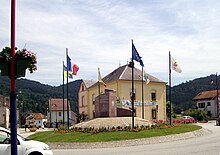Saint-Etienne-lès-Remiremont
| Saint-Etienne-lès-Remiremont | ||
|---|---|---|

|
|
|
| region | Grand Est | |
| Department | Vosges | |
| Arrondissement | Epinal | |
| Canton | Remiremont | |
| Community association | Porte des Vosges Méridionales | |
| Coordinates | 48 ° 1 ′ N , 6 ° 36 ′ E | |
| height | 370-819 m | |
| surface | 33.81 km 2 | |
| Residents | 3,840 (January 1, 2017) | |
| Population density | 114 inhabitants / km 2 | |
| Post Code | 88200 | |
| INSEE code | 88415 | |
 Location of the commune of Saint-Étienne-lès-Remiremont in the Vosges department |
||
Saint-Étienne-lès-Remiremont is a French commune with 3840 inhabitants (as of January 1, 2017) in the Vosges department in the south of the Grand Est region . It is part of the Épinal arrondissement and the Porte des Vosges Méridionales municipal association .
geography
The municipality of Saint-Étienne-lès-Remiremont borders directly on the city of Remiremont , with the upper Moselle forming the dividing line. The Moselotte, which comes from the Vosges , flows into the Moselle southeast of the core town.
The municipality of Saint-Étienne-lès-Remiremont, which encompasses 33.8 km², extends from the mouth of the Moselotte along the right bank of the Moselle over a length of almost ten kilometers to the north. The municipality also includes the wooded foothills of the Vosges Mountains east of the Moselle , which belong to the Forêt de Fossard, as well as a 100 to 500 meter wide plot of land south of the core town that extends as far as the Rhine-Rhône watershed . At 819 meters above sea level, the highest point is reached in the northeast of the municipality. Other elevations are the Roche du Thin (757 m) and the Saint-Mont viewpoint (667 m). In the municipality of Saint-Étienne, the mountain streams Ruisseau de la Suche, Ruisseau de Seux and Ruisseau de la Croisette flow to the Moselle.
The Moselle valley in the Remiremont / Saint-Étienne area is about 2000 meters wide, which favored the establishment of settlements on both sides of the river. The valley floor is characterized by built-up plots, north of the core town there is arable land and meadow land.
The districts of Seux and Xennois , which belong to the municipality, have now merged with Saint-Étienne. On the opposite bank of the Moselle from Saint-Nabord lies the district of Méhachamp , to the south of the hamlet of La Croisette .
Neighboring municipalities of Saint-Étienne-lès-Remiremont are Éloyes in the north, Tendon in the northeast, Cleurie and Saint-Amé in the east, Dommartin-lès-Remiremont in the southwest and south, Girmont-Val-d'Ajol and Le Val-d'Ajol in the southwest and Remiremont and Saint-Nabord in the west.
history
Sancti Stepha - today's Saint-Étienne - was first mentioned in the 7th century . Since the Middle Ages, Saint-Etienne was a bone of contention between the Dukes of Lorraine and the monastery in Remiremont.
The outbreaks of plague and leprosy left sixty surviving residents in 1710. In 1804 Saint-Étienne again had 1,322 inhabitants.
During the French Revolution, the municipality was called Val Moselle . In 1937, Saint-Étienne was renamed to Saint-Étienne-lès-Remiremont to better distinguish numerous communities of the same name in France .

coat of arms
The wavy lines in the shape of a Göpel symbolize the confluence of the Moselle and Moselotte rivers , the key and the patriarchal cross are reminiscent of the former rulers of the community, the tower represents the parish church. The spindle represents the long tradition of the local textile industry.
Population development
| year | 1962 | 1968 | 1975 | 1982 | 1990 | 1999 | 2007 | 2017 | |
| Residents | 3369 | 3741 | 3936 | 4497 | 4085 | 4057 | 3899 | 3840 | |
| Sources: Cassini and INSEE | |||||||||
The commune of Saint-Étienne-lès-Remiremont grew continuously until the 1980s, since then the decline of the textile industry has been noticeable on the population.
Attractions
- Chapel of Sainte-Sabine
- “Kerlinken”, a five-meter-high menhir in the Forêt de Fossard
- Saint-Etienne church, built in the 18th century
partnership
Saint-Étienne has had a partnership with the Portuguese city of Vila das Aves since 1986, which goes back to numerous guest workers from Vila das Aves in the textile industry between 1960 and 1975.
Economy and Infrastructure
Agriculture and forestry play a subordinate role in the municipality, but there are 21 farms in the municipality (dairy, cattle and poultry farming). Vegetable growing and horticulture are also worth mentioning. Saint-Étienne is an industrial municipality, in the Grands Moulins business park and in the south of the core town there are numerous companies in various industries that offer over 1000 jobs.
The heavily frequented Route nationale 66 ( European route 512 ) from Épinal via the Col de Bussang to Mulhouse leads southwest of the core town along the left bank of the Moselle. In Saint-Étienne, Départementsstrasse 417 branches off from this nationally important road to Gérardmer and Colmar . There are connections to Épinal and Nancy in the nearby Remiremont train station .
supporting documents
- ↑ brief history on ville-st-etienne-remiremont.fr/ (French)
- ↑ Coat of arms on genealogie-lorraine.fr
- ↑ Saint-Étienne-lès-Remiremont on cassini.ehess.fr
- ↑ Saint-Étienne-lès-Remiremont on insee.fr
- ↑ Farms on annuaire-mairie.fr (French)
Web links
- Community presentation (French)
- Saint-Étienne on france-pittoresque.com (French)
- Population statistics


